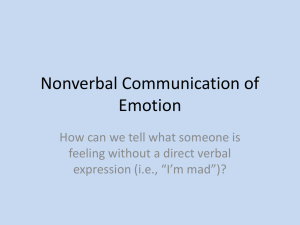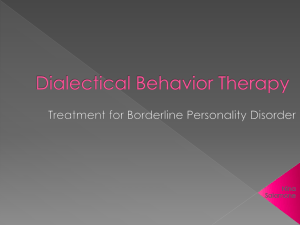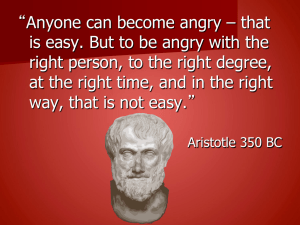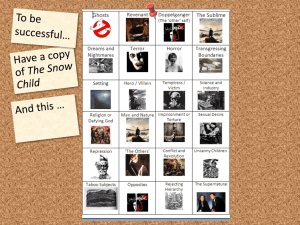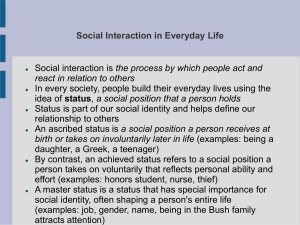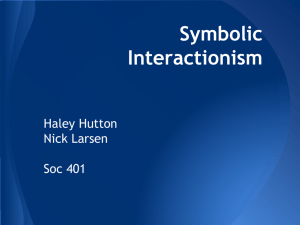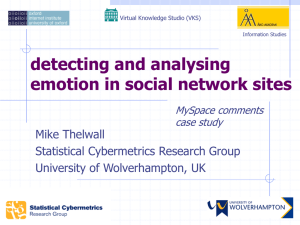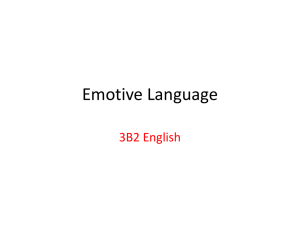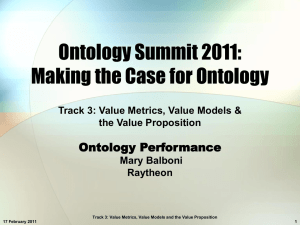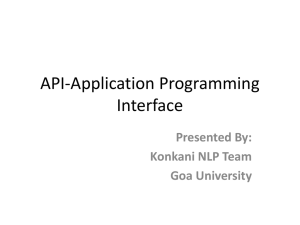pptx - emotive
advertisement
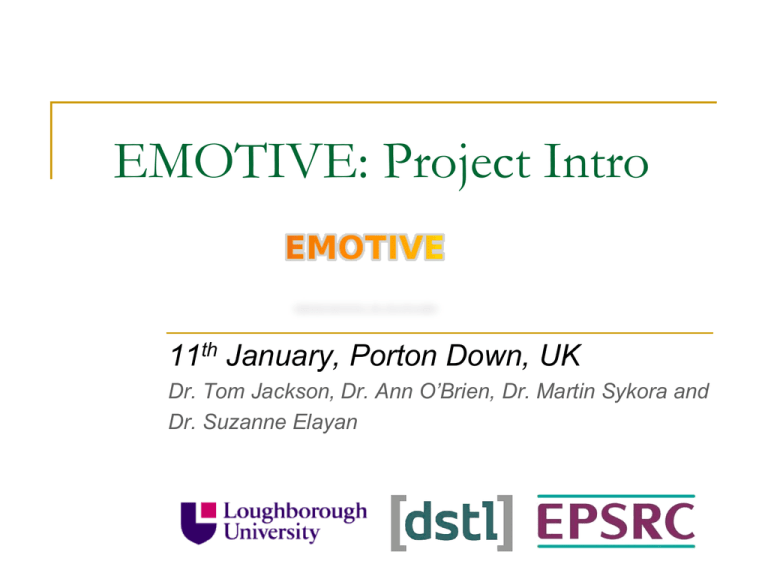
EMOTIVE: Project Intro 11th January, Porton Down, UK Dr. Tom Jackson, Dr. Ann O’Brien, Dr. Martin Sykora and Dr. Suzanne Elayan Contents Introduction to EMOTIVE System Design Walkthrough & Issues Emotions / Ontology Conclusions Introduction Overview Data Store -MySQL -MongoDB System Design Emotions / Ontology Conclusions (Extracting the Meaning Of Terse Information in a Visualisation of Emotion) Introduction System Design Emotions / Ontology Conclusions Unique System Features of EMOTIVE Provides Deeper Sentiment Analysis Provides Automated Semantic Alerts Determine Strength of Emotion Provides Intelligent Geo-Tagging Provides a Unified Approach – currently available social media monitoring software systems specify sentiment generally, e.g., positive, neutral, negative (SocialMention). EMOTIVE will indicate activity displaying emotion by means of an ontology which will identify sentiment in a highly specific way by identifying human emotions such as ‘horrified’ with all its related synonyms (‘disgusted’, ‘outraged’, etc.). – analysts, if searching using a particular emotive word will be automatically alerted to messages which include semantically related words and thus will see a richer and more nuanced set of results which will provide more accurate monitoring. For example, if looking for ‘Leicester’ related tweets it will also bring back synonyms like ‘Lesta’. – EMOTIVE will specify strength of emotion based on a rating of the meaning of the word as embedded in the ontology, not on the simplistic scale currently available. – EMOTIVE will provide a geo-location based monitoring system (not derived just from geo-tags, but using vernacular and location indicators) that will display via an interactive and dynamic map, highlighting hotspots where emotional messages are clustering. – EMOTIVE combines in one system the extracting of text, searching by emotion and geo-location to provide a more detailed accurate picture, unlike other systems available. Introduction System Design Emotions / Ontology Conclusions 1. M6 Megabus Bomb-Alarm incident 2. Serious Kings Cross Tube Station Overcrowding (just ahead of the summer Olympics) 3. 2012 Belfast Riots 4. September 2012 English Floods (River Ouse, River Weaver, River Severn, etc.) 5. Al-Hilli Bomb (Claygate) Scare 6. 11th September 2012 7. PC Manchester Shootings Aftermath and Guns for Police debate (Funeral of the Police Officers – and reactions towards Dale Cregan) 8. Olympic Parade, Closing / Opening Ceremony – Olympics / Paralympics coverage 9. Alps Shooting and Al-Hilli spy accusations 10. Government Reshuffle 11. Nick Clegg 12. TUC Strike scare 13. Job Losses / Unemployment (reactions to JJB Sports bankruptcy) 14. DNC (USA Democratic National Convention 2012) Introduction System Design Emotions / Ontology Conclusions Sparse Text Monitoring and Retrieval: Spam removal rules – common characteristics of spam used to detect spam messages (e.g. #hashtag piggybacking) Detect picture sharing website-use over Twitter, play an integral part in conversations -pic.twitter, yfrog, twitpic, twitgoo, instagr.am, flic.kr, path Tweak thecrisis Tweet mapping standard: community used hashtags; TtT standard Detect Before: Altagrace Pierre needs at Delmas 14 House no. -Egyptian activist; “We use help Facebook to schedule our14. protests, Twitter to After: #haiti #name Altagrace Pierre #need help #loc Delmas 14 House no. 14 coordinate and YouTube to tell the world .” (Meier 2011) Evolution of terms / slang / hashtags – monitoring the evolution of new vocabularies (edit distance, soundex, megaphone,…) Source: Meier, 2011. Do ‘liberation technologies’ change the balance of power between repressive states and civil society?, PhD Thesis; Starbird, 2010, http://www.cs.colorado.edu/~starbird/blog/tweak_the_tweet_-_social_an.html Introduction System Design Emotions / Ontology Conclusions Geo-Location: Geo-tagged content ~ 1%-1.6%, (3.5%) - TtT & crisis response community encourages people to use geolocation in times of crises -Location Services, e.g. Foursquare (3 million check-ins per day) e.g. "I am at Starbucks - Santa Clara (link to map) w/@mediaphyter" Locations inferred from events #terremotochile (time-zone) or 2011 summer riots -low geo-location accuracy -quick & easy way Message content location mentions (geo-referencing gazetteers and some heuristics), i.e. landmarks, squares, monuments, roads, city-parts, etc. -e.g. #TahrirSquare (Starbird and Palen 2012), or #CarlisleCircus, #DenmarkStreet, Bottom of Antrim Road Source: Malleson and Birkin, 2012. Estimating Individual Behaviour from Massive Social Data for An Urban Agent-Based Model ; Starbird and Palen, 2012. (How) will the revolution be retweeted?: information diffusion and the 2011 Egyptian uprising; Ikawa, Enoki and Tatsubori, 2012. Location inference using microblog messages; Chen and Sakamoto, 2012. Perspective Matters: Sharing of Crisis Information in Social Media Introduction System Design Emotions / Ontology Conclusions Geo-Location: Dialectology based Geo-location; -based on explicit (known) linguistic differences -machine learning approach (Eisenstein et al. 2010, Kinsella et al. 2011): -location models (based on distribution of terms) -new message content classified based on similarity to models Sent from the ground or not; -Tweets sent from the midst of an incident, e.g. - “#BelfastRiots: As the crowd refuses to disperse, water cannon are deployed. pic.twitter.com/Qg9TnO4d “ -”Gotta a helicopter on my house again #belfastriots” -Can be common in crises, 30% of 1,000 most highly retweeted Tweets were sent from the ground (Starbird and Palen 2012; Egyptian Revolution) -User profile - user location (users to watch) Source: Kinsella, Murdock and O'Hare, 2011. "I’m Eating a Sandwich in Glasgow": Modeling Locations with Tweets; Eisenstein, O'Connor, Smith, and Xing, 2010. A Latent Variable Model for Geographic Lexical Variation Introduction System Design Emotions / Ontology Conclusions Emotion Extraction: Emotion detection; -Shorthand Syntax and Slang -Booster words, repeated letters / words & punctuations (incl. emoticons) -Annotated emotion vocabularies (i.e. known emotion strengths) Higher level Emotion types recognition (in the Ontology) -Confusion (Shook up, Stunned, Chaotic, etc.) -Anger (enraged, infuriated, vengeful, etc.) Polarity of Emotion (in the Ontology) Source: De Choudhury and Counts, 2012. The Nature of Emotional Expression in Social Media: Measurement, Inference and Utility; Chen and Sakamoto, 2012. Perspective Matters: Sharing of Crisis Information in Social Media; Thelwall, 2009. Fk yea I swear: Cursing and gender in a corpus of MySpace pages Introduction System Design Emotions / Ontology Conclusions Personality User Profile: Building a psychological profile from common Emotions of a user -)Five-factor model of personality – or the “Big Five” -)Sentiment Model (based on distribution) e.g. http://tweetpsych.com/?q=cotwj1 Measuring similarity between a user’s profile and their current emotions (are the emotions “out of range”) Source: Goldberg, Johnson, Eber, Hogan, Ashton, Cloninger and Gough, 2006. The international personality item pool and the future of public-domain personality measures. Journal of Research in Personality, 40; Costa and Mccrae, 2005. The Revised NEO Personality Inventory (NEOPI-R). SAGE Publications Emotions / Ontology Conclusions Although all of these words are more or less synonymous with anger, they do not all indicate the same level of anger. For example, “infuriated” is a much stronger type of anger than “cross”. Three levels of emotions were introduced: Moderate, Medium and Strong. Each word is tagged according to its emotional strength. The model used to classify the levels of emotion is Tom Drummond’s Vocabulary of Emotions. Introduction System Design Emotions / Ontology Conclusions However, there are words that can be added to emotional words to increase or decrease their level of emotion. These words are known as “intensifiers”. Each intensifier is given a property to either increase or decrease the level of emotion. Each intensifier added can increase the level of emotion either one level up or one level down. Two more levels of emotion were added for when intensifiers are added to Strong or Moderate words. For example, if “a bit”, a decreasing tool, is added to “cross”, a moderate word, the level of emotion goes one level up to become Light. Introduction System Design Emotions / Ontology Conclusions When negating words are used before a word that expresses emotion the meaning of that word changes. For example, adding “not” to an emotional word such as “angry” nullifies the anger. Each negating tool is given a property to nullify the level of emotion and the type of emotion (in this case, Anger). Introduction System Design Emotions / Ontology Conclusions - Ontologies are at the core of the EMOTIVE system; they facilitate deeper semantic analysis - Geo-location (on par with state-of-the-art techniques, used in crisis mapping applications) - User-Profiles (Geo-location, Emotions, …) - Efficient Algorithms / Data-structures: Coping with large amounts of data, (near) real-time processing - Much of the discussion was concerned with Twitter, however the points made, and system elements / tasks equally relate to Facebook and Email based messages. Thanks

